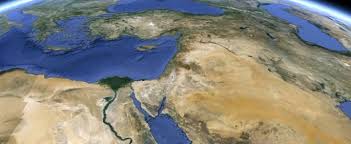It is the business of the counterfactual historian to yearn for the former Ottoman Empire when reflecting on the recent incessant regional instability. However, the fact that the empire was in free fall from 1798 onward makes a mockery of this view.
Nevertheless, from Libya to Yemen, and Syria to Iraq, conflict typifies the ruptures that are still hemorrhaging from the collapse of the Ottoman Empire in the Middle East just under a century ago.
The straight lines that divide today’s Middle East were drawn up by British cartographers as Ottoman forces withdrew from the Arab world. Contrary to popular belief, formal teachings of Arab lands was the last priority for the British, who were already in the throes of imperial overstretch. The traditional policy of the British government was to prop up the Ottoman Empire (Turkey) as a buffer against Russian expansion. Britain feared Russian designs on India, its most important colonial possession. Leading British statesmen such as former Prime Ministers Lord Palmerston, Benjamin Disraeli and the Marquis of Salisbury had held the view that a Russian fleet in the Mediterranean might cut British sea routes to India.
However Turkey’s alliance with Germany coupled with French, Russian and Italian ambitions on Ottoman territory complicated the matter, and following Mark Sykes’ meeting with a certain Francois Georges-Picot, a new Middle East consisting of new nation states came about, one that has arguably never succeeded. Within this context the region exchanged one security umbrella for another and has yet to mature as an independent force on the world stage. Initially the British lacked the appetite and resources to enact long-term stewardship over the region and the French experiment in Syria and Lebanon was woefully unsatisfactory.
Seeking apparatus to work more cohesively irrespective of hurriedly conceived borders would be beneficial for regional states — as the ramifications of decisions taken between 1914 and 1922 still guide conflicts today.
Zaid M. Belbagi
When US Assistant Secretary for Near Eastern Affairs Joseph Sisco met with British counterparts in 1968 to organize a handover of power responsibilities for the region, the US was most concerned with containing communism. Aside from the liberation of Kuwait in 1991 (incidentally a regional conflict linked directly with legacy issues concerning the Ottoman Basra Vilayet), the US has shown a lack of commitment to regional affairs, most recently confirmed by the previous US administration’s “Pivot to Asia,” as the security complex of the South China Sea tinderbox has taken priority. A century on, the region’s haphazard exchange of security guarantors has invited the interference of a host of foreign actors, a direct result of how the post-Ottoman vacuum was inadequately filled.
In an increasingly globalized international system the region has never recovered from losing the political and civilizational hub it had in Constantinople. Successive regional multinational bodies have been unable to build links between the nation states of the Middle East in anything close to the former Ottoman system. The United Arab Republic, Arab Common Market, the Federation of Arab Republics, Arab League and the Greater Arab Free Trade Area read as a list of organizations unified in their inability to foster strong diplomatic and economic links between the nations of the Arab world.
Though ongoing regional conflicts are of course political in nature, stunted economic development across the Arab world is a leading factor contributing to instability. One interesting cause for this is that despite the globalization of the world, the Middle East remains one of the most fragmented regions in terms of trade, economic and production linkages.
Despite a population of 350 million sharing a common language, the Arab world has yet to function as a single economic market. Pan-Arab trade is remarkably low as few Arab countries consider their immediate neighbors as trading partners. Though it has recently increased, the share of intra-Arab trade in total merchandise trade remains around 10 percent. This is critical, as over the same 20-year period exports from South Asia and the Arab world have increased to 18 percent and Turkey’s share has increased to 21 percent.
Though statistics differ between Arab countries, thick borders have caused regional fragmentation of trade, which is in stark difference to the Ottoman economic model where European and Asian markets were directly connected through the empire, traversed by railroads which invigorated trade and commerce across the empire. The Hejaz Railway connecting Damascus and Madinah, which closed in 1920, remains the region’s most recently operational transnational railway network.
Returning to the opening premise of this piece, the most problematic legacy of the Ottoman break-up has been the carving up of the region irrespective of cultural, religious and tribal realities. In the region’s most pressing conflict, the boundaries of the Syrian state have shown themselves to be fragile with a Kurdish uprising in the north, an Alawite colony to the west and the country’s eastern border having become a wholly porous frontier with Iraq. There are those who argue that a complete overhaul of the territorial status quo is required to overcome such challenges. Regardless, seeking apparatus to work more cohesively irrespective of hurriedly conceived borders would be more beneficial for regional states — as the ramifications of decisions taken between 1914 and 1922 still guide conflicts today.
• Zaid M. Belbagi is a political commentator. He also acts as an adviser to private clients between London and the Gulf Cooperation Council (GCC).



















